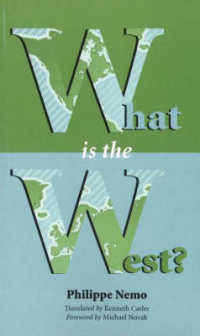Full Description
The appeal of manga is undeniable. As a worldwide publishing phenomenon, it has deservedly garnered the attention of scores of young learners. School librarians are willing and excited to harness its overwhelming popularity, and the benefits are real: with manga, you'll strengthen not only the circulation statistics in your school library but also engagement and inclusion. This easy-to-use guide will walk you through making it happen. Inside, you'll discover
12 adaptable lesson plans that incorporate the AASL Standards, with additional national and content-specific standards also highlighted to enhance instructional partnerships;
dedicated information for elementary, middle, and high school librarians;
an overview of manga basics, such as key genres and publishers;
advice on collection development, readers' advisory, and organizing in your space;
how manga collections and programming connect with and through all six of AASL's Shared Foundations;
guidance on ways to integrate manga into your lesson planning, including anime club content that nurtures a feeling of community;
how manga connects with and through learners from marginalized communities;
personal librarian stories beautifully illustrated manga-style by both high school learners and co-author Sybil M. TourÉ; and
an appendix of manga recommendations sorted by age group and a helpful glossary.
Contents
Using This Guide
Part I Getting Started with Manga
Chapter 1 The Basics of Manga as a Format
Chapter 2 You Don't Have to Be an Expert: Manga Advocacy for Everyone
Part II Manga in the School Library Space
Chapter 3 Foundational Information about Manga
Chapter 4 Collection Development
Chapter 5 Ordering and Maintaining Manga
Chapter 6 Physical Organization in Your Space
Part III Manga and Student Engagement
Chapter 7 Readers' Advisory
Chapter 8 Manga and Marginalized Communities
Part IV Manga and Instruction with Lesson Plans
Chapter 9 Manga in ELA Classes and Reading Electives
Lesson 9.1 Reading Manga for the First Time with Yotsuba&!
Lesson 9.2 Test Prep with Demon Slayer
Lesson 9.3 Introducing Manga in a Classroom Setting with My Hero Academia
Lesson 9.4 Fullmetal Alchemist and the Value of a Human
Chapter 10 Manga Across the Curriculum
Lesson 10.1 Environmental Science with Studio Ghibli
Lesson 10.2 Cells at Work! with Middle School Science
Lesson 10.3 Okinawa and the Impacts of War on Colonized People
Lesson 10.4 Blank Canvas: My So-Called Artist's Journey and Art Studies
Chapter 11 Manga in Clubs
Lesson 11.1 Creating Your Own Anime Awards
Lesson 11.2 Character Debates on a Continuum
Lesson 11.3 Manga and Anime Journals
Lesson 11.4 Running an Anime and Manga Club for Elementary Learners
Part V Manga After School
Chapter 12 The Digital Landscape
Chapter 13 Anime Clubs as Community Builders
Appendixes
Appendix A Manga by Genre
Appendix B From the Mall Bookstore Floor to School Librarianship: An Otaku Story
Appendix C Bringing Hobbies Together through Manga and Cosplay
Appendix D The Strength of Creative Communities, and Being the Change
Glossary
Bibliography
About the Authors and Contributors
Index
SPECIAL FEATURE: Falling into Fandom
-

- 電子書籍
- 巨蟲山脈【電子単行本】 4 ヤングチャ…
-

- 電子書籍
- 八咫烏シリーズ外伝 すみのさくら 新カ…
-

- 電子書籍
- マンガでわかる オトナ女子のための乳が…
-

- 電子書籍
- オリンピックと東京改造~交通インフラか…




